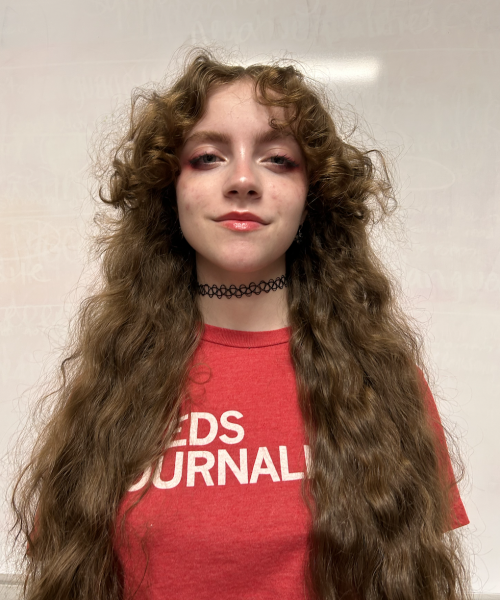Casual Representation: censorship and positive examples
There is a fine line between representation and censorship: it has much to do with intentions, comfort and discomfort.
The LGBTQ flag in a Pride march in 2022
April 18, 2023
Though media content largely overlooks the use of casual representation to portray minority characters, as covered in a recent article, there are examples throughout the decades; however, censorship and queer baiting have come to overpower the positive inclusivity, especially when it comes to sexuality and gender identity.
Though the lines between censorship and casual representation appear blurry, as both can omit labeling characters or relationships, the difference comes with the writer and producer’s intentions.
Censorship omits labels to keep audiences comfortable with heterosexist mentalities and tendencies while pandering to queer or ally audiences through queerbaiting. Despite being on opposite ends of the spectrum, as censorship denies inclusivity while queerbaiting gives the illusion of inclusivity, they often appear together. The intentions come from a discomfort with LGBTQ+ characters appearing in media content while simultaneously capitalizing on those attempting to identify with any sort of representation.
“They try to capitalize off of representation [through queerbaiting] to bring in money from minorities,” said RV senior Kayla Reed. “But they don’t have good intentions of actually accurately representing people or representing them in any helpful way.”
In contrast, casual representation intends for the audience to see and understand the presence of queer characters without an explicit explanation; this directly challenges heterosexist biases. Casual representation is comfortable portraying queer characters without using that inclusivity as a marketing scheme or publicity stunt or attempting to hide the inclusivity.
Further, it is crucial to note that casual representation does not aim to undermine social progress or negate the significance of past and present struggles that minorities face; it intends to normalize acceptance rather than promote violence and aggression.
The film “Till” (2022), directed by Chinoye Chukwu, illustrates this idea. According to a CNN Entertainment article, the team behind “Till” said they worked hard to tell the story of Till sensitively by containing no physical violence against Black people while grounding the story in joy and dignity.
This positive framing humanizes the individuals, namely the victims portrayed in the movie, making the retelling about people rather than a name and a spectacle.
Throughout the years, a multitude of examples have entered the media, most recently and most commonly in the form of media mainly targeted toward tweens through young adults. By targeting a younger audience specifically, it allows that generation to grow up accustomed to differences amongst people.
Child psychologist Ebony Roberts found children to “take seriously what they see on television and uncritically incorporate it into their conception of how things are in the world.”
The show “Arcane” (2021) seamlessly includes a variety of racial, gender, and LGBTQ+ representation without ascribing any oddity to the presence of diversity as classism between the rich, prosperous Piltover and the poor, sickly Zaun plays an infinitely more significant role to the plot and character agency than what minority they are representing. Such is demonstrated in a scene in Episode 8: “Oil and Water.” After disappearing, Caitlyn, the daughter of a Piltover government leader, sneaks through her bedroom window with Vi, Zaunite; when the two girls are discovered, Caitlyn’s mother is disgusted by Vi, calling her “a stray.” Her diction alone distinguishes her distaste as classism rather than homophobia.
“Ruin and Rising,” the third book in Leigh Bardugo’s “Shadow and Bone” book trilogy, includes a lesbian relationship. Though the book suffers in some areas of gender representation, the lesbian relationship portrayed through Nadia and Tamar is casual representation. Though it was released back in 2014, the relationship is not questioned by other characters, nor is it described with any more or less gusto, liking, or distaste than any other romantic relationship in the series on the basis of sexuality. Like other relationships within the series, the description of this relationship matches how it appeases or juxtaposes the climate of the characters’ situation.
“The Owl House” (2020), by Dana Terrace, unlike the previous example, blurs the line between fantasy and reality. The universe is split between two realms: the Demon Realm, which its creator, Dana Terrace, confirmed is free of homophobia, racism, and sexism, and the Human Realm, which portrays reality. While living in the Demon Realm, Luz experiences complete freedom of expression and exists without labeling her bisexuality. Only upon returning to the Human Realm does she need to face the struggle of coming out; that struggle, however, does not overtake or even heavily influence the main plot, and she is only labeled through the visual of pride flags. Being Dominican-American, bisexual, female, and neurodivergent make her no more or less valid; her personality and character agency are much more important to why she is a successful protagonist.
Apart from modern media, “Giovanni’s Room,” published in 1956 by James Baldwin, portrays what could be considered causal representation, despite the misinterpretation and misrepresentation by society at the time. Baldwin never explicitly labels protagonist David’s sexuality but shows him to have had sexual encounters with men and women. Society perceived the book to be about homosexuality, while, according to an interview with Baldwin, he wrote the text to tackle “what happens to you if you’re afraid to love anybody. Which is much more interesting than the question of homosexuality.”
The prospect of casual representation remains nothing new in media content; however, society continues to respond with backlash and misinterpretation, which creates an environment in which positive representation remains difficult to curate and come across.
RV senior Kayla Reed stated that the media is the way we progress society forward because it gives people exposure to the normalized existence of minorities. That responsibility now falls on writers and distributors of media content to diversify content in a positive, normalizing manner, and on consumers to take in that normality and apply it to their mindset.






